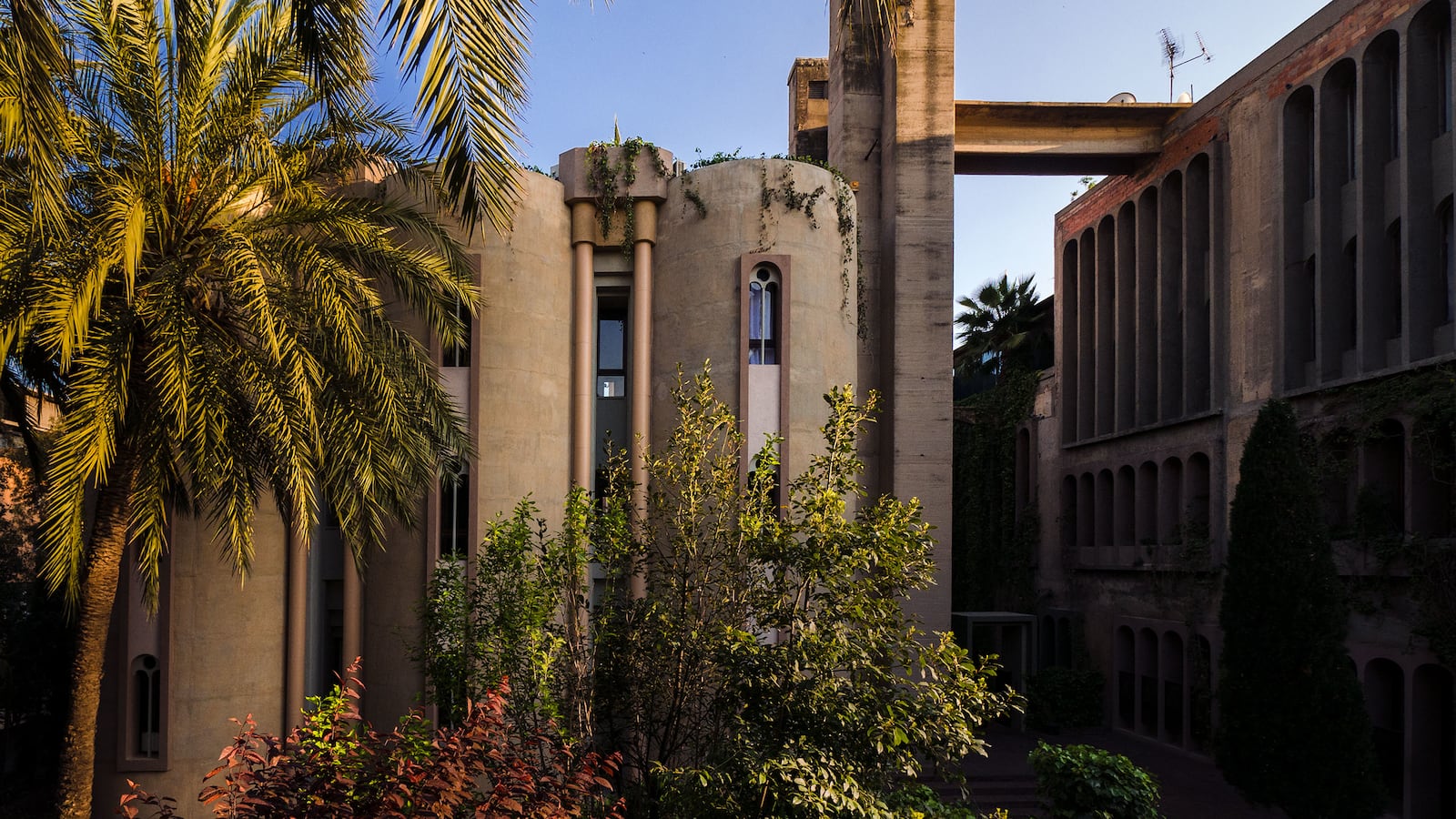Ricardo Bofill is perhaps the most famous architect alive whose name is not readily known by his own fans.
In an era where visibility and legacy are more and more determined by social media and pop culture penetration, few artists have dominated my social media over the past few years quite like Bofill. La Muralla Roja, his casbah-esque masterpiece outside Valencia, has become so popular with Instagrammers that residents have reportedly put up fencing. Les Espaces d’Abraxas, his classical yet post-modernist low-income housing complex on the outskirts of Paris was featured prominently in the final installment of The Hunger Games and the centerpiece of the unforgettable photo series of Paris housing estates by Laurent Kronental that went viral two years ago. One glimpse at the fat curve of his W Hotel tells viewers they are looking at Barcelona. The Santuario de Meritxell, Xanadú, Antigone, Kafka’s Castle, Les Arcades du Lac—the list of iconic works goes on and on. Show anybody photos of all these works and there’s a good chance they’ll recognize them, but also an equally good chance that they can’t name the man who designed it.














This is likely because the 77-year-old Bofill’s style and materials have changed so much from location to location over the decades. It would be hard to imagine that the ego and baroque planning of Abraxas could be the same deft and playful mind behind La Muralla Roja. Let alone jump from those two to his current project in Miami.
That willingness to leap from style to style can be seen in his two masterpieces—Walden 7 and La Fabrica—on the same street on the outskirts of Barcelona which are slowly becoming the next must-sees in a city that is already an architectural tourist mecca.

Walden 7
Courtesy of Ricardo Bofill Taller de ArquitecturWhereas his home and studio, La Fabrica, is a former cement factory turned into a brutalist-romantic synthesis, neighboring Walden 7 is a vertiginous fortress maze of azure, ochre, and yellow. Whereas La Fabrica has the breathtaking charm of that perfect village church, Walden 7 knocks the wind out of you like a Gothic cathedral.

Aerial view of La Fabrica
Lluís Carbonell Courtesy of Ricardo Bofill Taller de ArquitecturaBorn in 1939 in Barcelona, the son of a real estate developer, Bofill studied architecture in his home city and in Geneva, although he never finished. When he launched his first firm in 1963, he became notorious for hiring not only architects and engineers but also a poet and an archaeologist. (A practice that eventually died out.) His first major projects in the ’60s and ’70s were in Spain, and in the words of his firm, “recuperated the characteristic craft elements of traditional Catalan architecture.” These were the decades in which he designed what are now some of his most social-media-friendly projects: Meritxell, Kafka’s Castle, Xanadú, and Walden 7.
The ’80s, however, saw a dramatic (and to some inexplicable) shift into colossal Classicist works in France such as Les Arcades du Lac (“Versailles for the people,” Bofill once called it), Abraxas, Les Eschelles du Baroque, and Antigone. His buildings became so monumental that one New York Times critic dubbed them “disturbing” and “overbearing, perhaps even Napoleonic in their need to be large.”














In the ’90s those monumental distorted Classicist buildings entered the realm of skyscrapers, the most recognizable work for Americans from this period probably being 77 West Wacker on the Chicago River.
The thread connecting his early works with his postmodern classicism is his obsession with architecture tied to history and region, and his running battle against preeminent 20th-century architects’ contrary obsession with forgetting that same history.
Early in his career, in the ’60s and ’70s, he opposed Le Corbusier’s idea of the universal city, which Bofill saw as creating unnecessary divisions. In an interview with ArchDaily, he explained he didn’t like how in the ’20s and ’30s, “history became forbidden” and that “Le Corbusier and Mies van der Rohe were followed blindly all over the world.” Bofill’s answer to Corbusier’s vision could be found in the complexes like Muralla Roja and Xanadú, which were all about connectivity and were reinterpretations of regional historical design.
The rise of Post-Modernism in the ’80s created opportunities for large-scale neo-historicist architecture that Bofill specialized in. And so while his work in France at this time might at first glance seem starkly different from that of his early work, it makes sense if one thinks about him continuing to evolve his historicist and regionalist vision.

W Hotel Barcelona
Courtesy of Ricardo Bofill Taller de ArquitecturaIn that same interview, he went on to say, “when Post-Modernism became accepted and popular in the United States and worldwide it also became a style. And with time it became ironic and even vulgar. Once it became a movement, I was no longer interested.” Since the new millennium, Bofill has evolved even further, and his works have run the gamut from soaring glass and steel works like the W in Barcelona or his proposed 712-foot Miami tower to fusions of his architectural evolution such as the Campus for Mohammed VI Polytechnic University in Marrakech.
But it is La Fabrica—Bofill’s home and studio that he bought in 1973 when it was still an abandoned cement factory on the outskirts of Barcelona—that has become iconic in the past few years. This is in no small part due to a viral post by Design Boom and the power of Instagram to drive architectural tourism. On a recent visit and tour of the studio, Pablo Bofill, the founder’s son, told The Daily Beast that they’ve gotten exponentially more requests for tours of late. Frequently, a handful of photographers can be seen on the property’s edges, angling to get the perfect shot.

Wandering through the complex, which can be visited by appointment, begins in the converted factory silos, which now house the offices of the studio, including Bofill’s minimalist office.

Studio offices
Lluís Carbonell Courtesy of Ricardo Bofill Taller de ArquitecturaThose fortunate enough to be taken inside the residence are in for a treat, as the open-plan, cube shaped, multi-level space stuns with the interplay of the former factory’s concrete walls, the cut-out traditional Catalan Gothic elongated arched windows, the wood of the furniture and shelves, inviting white slipcover sofas, and floor-to-ceiling white curtains.

Living area of La Fabrica
Lluís Carbonell Courtesy of Ricardo Bofill Taller de ArquitecturaFittingly, the tour becomes nothing short of a religious experience once you enter the hall dubbed La Catedral. A transformation of the old factory hall into a conference and exhibition space, the cavernous space is made intimate by the glow coming from the slightly oxidized concrete surfaces. It is here that the Escher-like surrealism of the property comes together. Hard but fraying concrete walls and giant metal funnels harmonize with light wooden floors and floor to ceiling windows that open the space up into the concrete and palm jungle of the garden outside.

La Catedral
Lluís Carbonell Courtesy of Ricardo Bofill Taller de Arquitectura“I started with a very romantic idea to bring nature into this industrial place,” Bofill once told an interviewer, and with La Fabrica he has succeeded.

La Fabrica
Lluís Carbonell Courtesy of Ricardo Bofill Taller de ArquitecturaJust down the street, at Walden 7, one can see firsthand why the very same Times critic who hissed about Bofill’s “Napoleonic” impulses also declared, “what is impressive, rather than simply imposing, about Mr. Bofill’s architecture is that these studies in Classicism are at the service of public housing—long the conspicuous and unfortunate failure of modern architecture in France.”

Entrance to Walden 7
William O'ConnorBuilt in 1975, the red-clay warren rising up 14 stories was originally part of a plan for multiple subsidized housing complexes, but was the only one completed. From the outside, it looks like a dystopian casbah—or an adobe Transformer. Upon entering one of its multi-story yonic openings however, one crosses over into a dizzying world of geometric atriums, bridges, and balconies of turquoise, orange, and lapis lazuli.

Interior of Walden 7
William O'ConnorIt is in Walden 7 that visitors can see Bofill in conversation (or loudly arguing) with Corbusier. It was Bofill’s attempt, in his words “to find alternatives to simplistic Modernism by bringing back the spirit of the Mediterranean town.” With Walden 7 Bofill was trying to find harmony between modern design and technology with thousands of years of vernacular architecture and planning, Corbusier, Bofill believed, “had a total disregard for history. He hated the city. He thought of cities and buildings as machines… Cities started 10,000 years ago, but for Le Corbusier history did not exist.”
One of the more colorful figures in architectural history was the 15th-century Florentine financier Giovanni Rucellai. The third-richest man in Florence, he was the money behind Leon Battista Alberti’s designs for the Palazzo Rucellai and the facade of Santa Maria Novella. But he also was behind one of my favorite maxims. Men have two roles: the first is to procreate, and the second is to build, and man builds to honor God and to bring glory to his city and his family.
Ricardo Bofill has certainly done that.






